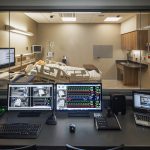How Has Technology in Education Changed?
The first portable computer was introduced in 1981 and the first mass-market consumer laptops in 1984/1985. By 1990, the World Wide Web made information readily available in a way only dreamed about, and, according to Purdue University Online, “by 2009, 97% of classrooms had one or more computers, and 93% of classroom computers had Internet access. For every 5 students, there was one computer.”[1]
When asked how technology in education has changed in the past 20 years, most people will point to the use of computers and the internet in everyday classroom learning. It is true that this was a huge shift in education over the past two decades; however, other areas of education have undergone similarly dramatic shifts with the introduction of audiovisual elements, need for heightened security, and a trend toward integrated educational facilities.
How Have Audiovisual Systems Impacted Learning?
In the early 2000s, teachers would have used a combination of whiteboards and overhead projectors to demonstrate a lesson to the class as a whole. Today, technology in education has changed to include smart boards and projectors that connect wirelessly to the computer, laptop, or other device preferred by the instructor. Students can also connect to and project their work.
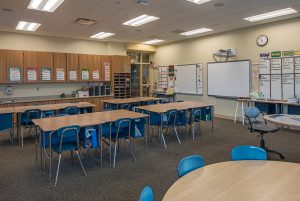 Students today are currently in a time often referred to as “the age of information.” Instructors at every level can take advantage of this through educational videos and interactive presentations. To get the most out of these opportunities, classrooms need to have the proper equipment to not only project the video, images, or presentation, but to present the audio in a way that can be heard by all. Few things are more frustrating to a student than when the lesson cannot be heard. Hearing is also a critical first step to processing and retaining information that may need to be recalled for a test or project later in the course.
Students today are currently in a time often referred to as “the age of information.” Instructors at every level can take advantage of this through educational videos and interactive presentations. To get the most out of these opportunities, classrooms need to have the proper equipment to not only project the video, images, or presentation, but to present the audio in a way that can be heard by all. Few things are more frustrating to a student than when the lesson cannot be heard. Hearing is also a critical first step to processing and retaining information that may need to be recalled for a test or project later in the course.
Many classrooms are also taking advantage of video recording capabilities. Some subjects, such as speech, can benefit from video playback, which allows students to see and hear themselves to identify where they can make improvements. By recording lessons and presentations, teachers can keep their students on track even if the instructor or students are absent from the classroom. Recorded lessons can also be used in a “flipped classroom” setting, where the instructor records a lesson for the students to watch before the class meets. This allows time with the instructor to be used for questions and to work through live examples, rather than lecture.
How Has School Security Evolved?
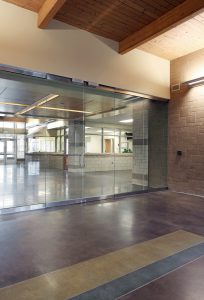 At the start of the 21st century, people thought nothing wrong of walking right into schools. Unfortunately, the last 20 years have also seen some of the greatest school tragedies. For this reason, leaders, teachers, and parents are all looking for ways to better protect students and staff at every educational facility around the world.
At the start of the 21st century, people thought nothing wrong of walking right into schools. Unfortunately, the last 20 years have also seen some of the greatest school tragedies. For this reason, leaders, teachers, and parents are all looking for ways to better protect students and staff at every educational facility around the world.
Building security addresses key areas of exposure both outside and inside the building. Electronic access control systems are used on exterior doors to limit outside traffic into the building, and in many cases, create one point of secured entry. Visitors must use one designated entrance, often monitored by video surveillance, and be approved by an office secretary or security guard. Additionally, securing interior doors not only limits the movement of possible intruders, but ensures that sensitive materials, such as chemicals for science labs, are safely stored.
What About the Computers?
It is true that over the last two decades, technology has become synonymous with learning. However, what many do not consider is how much an educational facility’s infrastructure has needed to evolve in order for the computers and internet to function effectively as an aid in classroom learning.
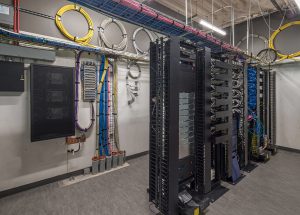 Students rely on fast, smooth internet for research and instructional videos. As the layout of “the standard classroom” continues to evolve, wireless networks provide instructors and students with the ability to easily form breakout groups and work where they are most productive, inside or outside a traditional classroom. The structured cabling system within a building is the critical backbone that supports this connectivity. It should be designed with the flexibility to meet today’s needs and allow for the migration to new technologies as they become available.
Students rely on fast, smooth internet for research and instructional videos. As the layout of “the standard classroom” continues to evolve, wireless networks provide instructors and students with the ability to easily form breakout groups and work where they are most productive, inside or outside a traditional classroom. The structured cabling system within a building is the critical backbone that supports this connectivity. It should be designed with the flexibility to meet today’s needs and allow for the migration to new technologies as they become available.
Where Should Schools Start?
The second half of the 20th century saw a technology boom that fundamentally changed the way people live today. Many people consider internet access in homes, businesses, restaurants, and schools to be a standard and they have come to expect technology to foster convenience. This is clearly showcased in the integration of technology into buildings. Internet access, digital signage, even wireless charging for cell phones are expected without the negative aesthetics of countless wires. This makes planning essential for any building, especially educational facilities.
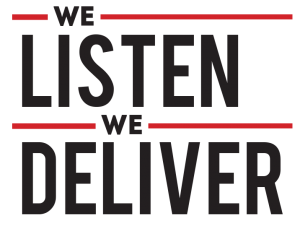 There are many ways to create an effective technology plan; IP Design Group utilizes one called “Interactive Planning.” Interactive Planning is a process that starts with listening to the client’s (in this case the school’s) needs and goals. This allows the team to give school administrators the best advice for technology infrastructure composition and layout, as well as audiovisual and security options specific to the needs of the individual school.
There are many ways to create an effective technology plan; IP Design Group utilizes one called “Interactive Planning.” Interactive Planning is a process that starts with listening to the client’s (in this case the school’s) needs and goals. This allows the team to give school administrators the best advice for technology infrastructure composition and layout, as well as audiovisual and security options specific to the needs of the individual school.
Just as learning is not a “one size fits all” for students, neither can technology design be generalized for every school, even every school within the same city or district. Many schools have different areas of focus, such as a math and science magnet school or serve a specific demographic. Creating educational environments that effectively address the unique needs of special education students or those with disabilities represent another example of the importance and benefit of advanced technology planning.
In today’s fast-paced world, technology is always changing and security is of upmost importance. IP Design Group’s experience and expertise in the technology and security industries, has allowed IP Design Group to work with school districts to ensure the proper technology and security improvements are implemented for today’s and future needs.”
– Jacob Butler, RCDD, technology and security designer at IP Design Group
How Has COVID-19 Impacted Where Technology in Education Will Go From Here?
In 2020, education systems around the world were presented with an entirely new challenge with the rise of the COVID-19 pandemic. Educational facilities at every level were forced to close their physical doors, and online learning became essential seemingly overnight. Technology, such as webinars and virtual meetings, became educational leaders’ answer to moving students forward while maintaining everyone’s health and safety.
Without the steady introduction of technology into the classroom, this sudden transition to solely online learning never would have been possible. There is no way to predict exactly how education will adapt to a post-COVID 19 world, but it does present many opportunities for improvement inside and outside the classroom.
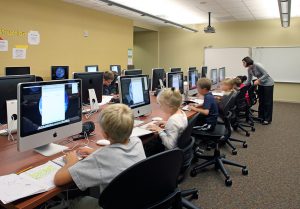 For instance, technology can be used to monitor the number of students in a school building. The current pandemic has caused the education industry to look for ways to safely allow students back into their physical schools. Some districts are now exploring leveraging technology such as Real-Time Location System (RTLS) systems to allow for student populations to be more precisely monitored and allow a means for quickly producing reports of exposure incidents identifying those students potentially affected.
For instance, technology can be used to monitor the number of students in a school building. The current pandemic has caused the education industry to look for ways to safely allow students back into their physical schools. Some districts are now exploring leveraging technology such as Real-Time Location System (RTLS) systems to allow for student populations to be more precisely monitored and allow a means for quickly producing reports of exposure incidents identifying those students potentially affected.
Through experience and strategy, teams like IP Design Group provide insight on current design trends, technology applications, and low operational cost. Understanding current technology and the direction its growth will take, enables technology specialists and school administrators to design educational technologies that will serve students’ and teachers’ needs for years to come.
Where Can I Learn More?
To see examples of technology systems integrated into schools, visit IP Design Group’s online portfolio.
Learn more about how technology helps healthcare students better prepare for careers in one of the world’s most important industries.
Visit Purdue Online’s article to learn more about evolving technologies in the classroom from an education perspective.
Works Cited
[1] Purdue University. (2020). The Evolution of Technology in the Classroom. Retrieved May 8, 2020, from Purdue University Online: https://online.purdue.edu/blog/education/evolution-technology-classroom









